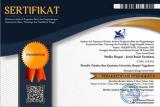PENGARUH INPUT SOMATOSENSORI DENGAN AKTIVASI PADA EKSTREMITAS BAWAH TERHADAP KONTROL POSTURAL PADA PASIEN STROKE
Abstract
Latar belakang: Pasien dengan stroke akan mengalami gangguan sensorik, depresi, postural kontrol, gangguan keseimbangan, gangguan pola berjalan, dan gangguan kemampuan fungsional serta aktivitas sehari-hari. Tujuan: Untuk mengetahui pengaruh pemberian input somatosensory dengan aktivasi pada ektremitas bawah terhadap peningkatan kontrol postural pada pasien stroke. Pilihan modalitas sensorik dicakup ketika mempertimbangkan intervensi sensorik (misalnya somatosensory, vestibular, pendengaran dan multisensory). Sehingga input sensori dengan aktivasi pada ektremitas bawah pada pasien stroke sangat diperlukan untuk meningkatkan kontrol postural. Metode: Jenis penelitian ini merupakan penelitian eksperimental dengan rancangan two group pre test dan post test. Kelompok yang diteliti adalah pasien hemiparese post stroke iskemik yang diberi input somatosensory dengan aktivasi ektremitas bawah. Jumlah sampel berdasarkan rumus di atas adalah 14 pasien stroke jenis stroke iskemik. Uji normalitas data menggunakan uji Saphiro-Wilk karena jumlah sample kurang dari 50. Selanjutnya dilakukan uji T-test tidak berpasangan untuk mengetahui ada tidaknya pengaruh yang bermakna. Hasil: Fugle Meyer Assesment Lower Extremity pada kelompok perlakuan menunjukan bahwa terdapat perubahan yang signifikan dengan p Value = < 0,0001, sedangkan pada kelompok kontrol menunjukan bahwa tidak terdapat perubahan yang signifikan dengan p Value = 0,848. Untuk Postural Assesment Scale For Stroke Patient (PASS) pada kelompok perlakuan bahwa terdapat perubahan yang signifikan dengan p Value = 0,0014, sedangkan pada kelompok kontrol menunjukan bahwa tidak terdapat pengaruh yang signifikan dengan p Value = 0,1700. Kesimpulan: Ada pengaruh pemberian input somatosensory pada ekstremitas bawah terhadap kontrol postural pasien stroke.
Keywords
Full Text:
PDFReferences
References
Alison M. Aries, P. D. (2022). Effectiveness of Somatosensory Stimulation for the Lower Limb. A Systematic Review.
Aries, A. M. (2020). Somatosensory stimulation to improve lower-limb recovery after stroke. Doctoral thesis, Keele University.
Asir John Samuel, J. S. (2015). A Critical Review on the Normal Postural Control. Review Article.
Boonstra, T. (2013). The Contribution of Each Leg to Bipedal Balance Control. Thesis ISBN 978-90-365-3544-1.
Coutney M. Butowics, A. J. (2021). Lower limb joint-specific contributions to standing postural sway in persons with unilateral lower limb loss. Scient Direct .
Dale Corbett, P. S.-B. (2017). Enhancing the Alignment of the Preclinical and Clinical Stroke Recovery: Consensus-Based Core Recommendations From the Stroke Recovery and Rehabilitation Roundtable Translational Working Group. Consensus Statements from the Stroke Recovery and Rehabilitation Roundtable.
David H. Saunder, C. A. (2014). Physical Activity and Exercise After Stroke. AHA Jurnal, Vol. 45, No. 12.
Diah, M. (2019). Ischemic Stroke Symptom, Risk factors, and Prevention. MEDIKA TADULAKO, Jurnal Ilmiah Kedokteran, 61-61.
Dias, S. (2014). How Can Somatosensory input (by Activation of foot and light touch contact) improve postural control, allowing an independent standing? Case Study-Stroke Rehabilitation. Bobath Course., 4-5.
Ekky Pujiana, S. A. (2018). Faktor-Faktor Yang Mempengaruhi Kejadian Stroke Pada Pasien Rawat Jalan Di RSUD KAbupaten Bekasi. Jurnal Penelitian.
Frederic Crevecoeur, D. P. (2016). Dynamic Multisensory Integration: Somatosensory Speed Trumps Visual Accuracy during Feedback Control. Article, Behavioral/Cogntive.
Heri, R. A. (2021). Hubungan Antara Rasio Trombosit Limpfosit Dengan Derajat Klinis Pasien stroke ISkemik Akut. Skripsi Thesis, Universitas Hasanudin.
Jannet Carr, R. S. (2010). Rehabilitation Optimzing Motor Performance. South Asia: Elsivier.
Jonas Schroder, S. T. (2017). Peripheral somatosensory stimulation and postural recovery after stroke . a systematic review, Volume 25, Issue 4.
Kesehatan, B. (2018). Hasil Utama RISKESDAS. Kementrian Kesehatan Republik Indonesia.
Lida Mademli, D. M. (2021). Standing on unstable surface Challenge Postural of Tracking Task and Modulates Neuromuscular Adjusments Specific to Task Complexity. Scientific Reports.
M.R. Bourich, S. M. (2015). Understanding the role of the primary somatosensory cortex: Opportunities for rehabilitation. Article Review.
Nikhil Sharma, J. C. (2013). Chapter 1 - Neural plasticity and its contribution to functional recovery. Journal and Book Sciencedirect.
Nili Stainberg, G. T. (2022). The impact of unexpected platform perturbation on ankle proprioception ability in static and dynamic starting positions. Scient Direct.
Ryosuke Chibaa, K. T. (2016). Human upright posture control models based on multisensory inputs; in fast and slow dynamicsHuman upright posture control models based on multisensory inputs; in fast and slow dynamics. Review Article.
Sang Hung Jang, J. H.-L. (2016). Impact of sensory integration training on balance among stroke patients: sensory integration training on balance among stroke patients. Open Medicine.
Sebastien Moyne-Bressand, C. D. (2018). Effectiveness of Foot Biomechanical Orthoses to Relieve Patients Suffering from Plantar Fasciitis: Is the Reduction of Pain Related to Change in Neural Strategy? Research Article .
Simon S. Kessner, M., Eckhard Schlemm, P., Bastian Cheng, M., & Ulrike Bingel. (2019). Somatosensory Deficits After Ischemic Stroke. DOI:1161/STROKEHA.118.023750.
Stephen JX Murphy, D. J. (2020). Stroke: causes and clinical features. Jurnal Elsivier.
Sue Raine, L. M.-E. (2009). Bobath Concept: Theory and Clinical Practice in Neurological Rehabilitation. United Kingdom: Blackwell Publishing Ltd.
Widjaja, P. &. (2015). Neurorestorasi Paska-stroke:Harapan Baru Penderita Stroke. Continuiting Medical Education.
Yochai Ataria, S. T. (2021). Body Schema and Body Image. United Kingdom: Oxford University Press.
DOI: https://doi.org/10.35842/mr.v19i1.962
Article Metrics
Abstract view : 184 ViewPDF - 54 View
Refbacks
- There are currently no refbacks.
Copyright (c) 2024 Medika Respati : Jurnal Ilmiah Kesehatan
Medika Respati : Jurnal Ilmiah Kesehatan indexed by:








